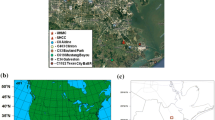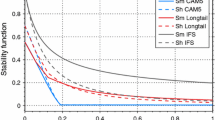Abstract
Discrepancies in grid structure, dynamics and physics packages in the offline coupled NWS/NCEP NAM meteorological model with the U.S. Environmental Protection Agency Community Multiscale Air Quality (CMAQ) model can give rise to inconsistencies. This study investigates the use of three vertical mixing schemes to drive chemistry tracers in the National Air Quality Forecast Capability (NAQFC). The three schemes evaluated in this study represent various degrees of coupling to improve the commonality in turbulence parameterization between the meteorological and chemistry models. The methods tested include: (1) using NAM predicted TKE-based planetary boundary height, h, as the prime parameter to derive CMAQ vertical diffusivity; (2) using the NAM mixed layer depth to determine h and then proceeding as in (1); and (3) using NAM predicted vertical diffusivity directly to parameterize turbulence mixing within CMAQ. A two week period with elevated surface O3 concentrations during the summer 2006 has been selected to test these schemes in a sensitivity study. The study results are verified and evaluated using the EPA AIRNow monitoring network and other ozonesonde data. The third method is preferred a priori as it represents the tightest coupling option studied in this work for turbulent mixing processes between the meteorological and air quality models. It was found to accurately reproduce the upper bounds of turbulent mixing and provide the best agreement between predicted h and ozonesonde observed relative humidity profile inferred h for sites investigated in this study. However, this did not translate into the best agreement in surface O3 concentrations. Overall verification results during the test period of two weeks in August 2006, did not show superiority of this method over the other 2 methods in all regions of the continental U.S. Further efforts in model improvement for the parameterizations of turbulent mixing and other surface O3 forecast related processes are warranted.
Similar content being viewed by others
References
Byun DW (1999a) Dynamically consistent formulations in meteorological and air quality models for multi-scale atmospheric studies. Part I: Governing equations in a generalized coordinate system. J Atmos Sci 56:3789–3807. doi:10.1175/1520-0469(1999)056<3789:DCFIMA>2.0.CO;2
Byun DW (1999b) Dynamically consistent formulations in meteorological and air quality models for multi-scale atmospheric studies. Part II: Mass conservation issues. J Atmos Sci 56:3808–3820. doi:10.1175/1520-0469(1999)056<3808:DCFIMA>2.0.CO;2
Byun DW, Dennis RL (1995) Design artifacts in Eulerian air quality models: evaluation of the effects of layer thickness and vertical profile correction on surface ozone concentrations. Atmos Environ 29: 105–126. doi:10.1016/1352-2310(94)00225-A
Byun DW, Schere KL (2007) Review of the governing equations, computational algorithms, and other components of the Models-3 Community Multiscale Air Quality (CMAQ) modeling system overview. Appl Mech Rev 59: 51–77. doi:10.1115/1.2128636
Davidson PM, Seaman N, Schere K, Wayland RA, Hayes JL, Carey KF (2004) National Air Quality Forecasting Capability: first steps toward implementation. Preprints, 6th conference on atmospheric chemistry: air quality in megacities. American Meteorological Society, Seattle, WA, 11–15 January 2004. J2.10
EPA, cited (2006) 2006 Summer ozone season—archive. Available online at http://www.airnow.gov
Hanna S, Hendrick E, Santos L, Reen B, Stauffer D, Deng AJ, McQueen J, Tsidulko M, Janjic Z, Sykes I (2008) Comparison of observed, MM5 and WRF-NMM model-simulated and HPAC-assumed boundary layer meteorological variables for three days during the IHOP experiment. Preprints, 15th conference on applications of air pollution meteorology. American Meteorological Society, New Orleans, LA, 20–24 January 2008. J1.2
Holtslag AAM, Boville BA (1993) Local versus nonlocal boundary layer diffusion in a global climate model. J Clim 6:1825–1842. doi:10.1175/1520-0442(1993)006<1825:LVNBLD>2.0.CO;2
Janjic ZI (1996) The Mellor–Yamada level 2.5 scheme in the NCEP Eta model. Preprints, 11th conference on numerical weather prediction. Norfolk, VA, American Meteorological Society, pp 333–334
Janjic ZI (2001) Nonsingular implementation of the Mellor–Yamada level 2.5 scheme in the NCEP meso-model, NCEP Office Note 437. Available at http://www.emc.ncep.noaa.gov/officenotes/FullTOC.html
Janjic ZI (2003) A nonhydrostatic model based on a new approach. Meteorol Atmos Phys 82: 271–285. doi:10.1007/s00703-001-0587-6
Lawrence MG, von Kuhlmann R, Salzmann M, Rasch PJ (2003) The balance of effects of deep convective mixing on troposheric ozone. Geophys Res Lett 30: 1940. doi:10.1029/2003GL017644
Lee SM, Yoon S-C, Byun DW (2004) The effect of mass inconsistency of meteorological field generated by a meteorological model on air quality modeling. Atmos Environ 38: 2917–2926. doi:10.1016/j.atmosenv.2004.02.008
Lin HM, Mathur R, Otte TL, Lee P, Pleim JE (2006) On the development of a vertical direct linkage between the WRF-NMM and CMAQ models. Preprint, 9th conference on atmospheric chemistry. American Meteorological Society, San Antonio, 13–18 January, J3.4
Mahrt L (1981) Modelling the depth of stable boundary layer. Boundary-Layer Meteorol 21: 3–19. doi:10.1007/BF00119363
McQueen J, Lee P, Tsidulko M, Tang Y, Huang H, Lu S, Mathur R, Kang D, Lin H, Yu S, DiMego G, Davidson P (2007) An overview of the NAM-WRF CMAQ Air Quality Forecasting System run operationally during the Summer 2007. Preprint, 6th annual CMAS conference, US EPA, Chapel Hill, NC, 1–3 October, pp 6.2. Available online at http://www.cmascenter.org/conference/2007/abstracts/
Mellor GL, Yamada T (1982) Development of a turbulence closure model for geophysical fluid problems. Rev Geophys Space Phys 20: 851–871. doi:10.1029/RG020i004p00851
National Research Council (1991) Rethinking the ozone problem in urban and regional air pollution. National Academy Press, Washington, DC
NCEP, National Centers for Environmental Prediction (2006) Near-surface forecast verification statistics for operational NCEP models: statistics by region and Quantitative Precipitation Forecast scores: Available at http://www.emc.ncep.noaa.gov/mmb/research/nearsfc/ and http://wwwt.emc.ncep.noaa.gov/mmb/ylin/pcpverif/scores/2006/200608/
Otte TL, Pouliot G, Pleim JE, Young JO, Schere KL, Wong DC, Lee PC, Tsidulko M, McQueen JT, Davidson P, Mathur R, Chuang HY, DiMego G, Seaman N (2005) Linking the Eta Model with the Community Multiscale Air Quality (CMAQ) modeling system to build a national air quality forecasting system. Weather Forecast 20: 367–384. doi:10.1175/WAF855.1
Pleim JE (2007) A combined local and non-local closure model for the atmospheric boundary layer. PBL model for meteorological and air quality modeling. Part 1: Model description and testing. J Appl Meteorol Climatol 46: 1383–1395. doi:10.1175/JAM2539.1
Pleim JE, Chang J (1992) A non-local closure model for vertical mixing in the convective boundary layer. Atmos Environ 26A: 965–981
Ryan WF, Piety CA, Luebehusen ED (2000) Air quality forecasts in the Mid-Atlantic region: current practice and benchmark skill. Weather Forecast 15:46–60. doi:10.1175/1520-0434(2000)015<0046:AQFITM>2.0.CO;2
Thompson A, Witte J (2006) INTEX ozonesonde network study August/September 2006. Available online at http://croc.gsfc.nasa.gov/intexb/SONDES/ions06_augsept.html
Thompson AM, Yorks JE, Miller SK, Witte JC, Dougherty KM, Morris GA, Baumgardner D, Ladino L, Rappenglueck B (2008) Tropospheric ozone sources and wave activity over Mexico City and Houston during MILAGRO/Intercontinental Transport Experiment (INTEX-B) Ozonesonde Network Study, 2006 (IONS-06). Atmos Chem Phys Discuss 8: 5979–6007
Timin B, Wesson K, Dolwick P, Possiel N, Phillips S (2007) An exploration of model concentration differences between CMAQ and CAMx. Preprints, 6th annual CMAS conference, US EPA, Chapel Hill, NC, 1–3 October 2007, pp 8.9. Available online at http://www.cmascenter.org/conference/2007/agenda.cfm
Tost H, Jöckel P, Kerkweg A, Sander R, Lelieveld J (2006) Technical note: a new comprehensive SCAVenging submodel for global atmospheric chemistry modeling. Atmos Chem Phys 6: 565–574
Vogelelezang DHP, Holtslag AAM (1996) Evaluation and model impacts of alternative boundary-layer height formulations. Boundary-Layer Meteorol 81: 245–269. doi:10.1007/BF02430331
Wyngaard JC (1973) On surface layer turbulence. Workshop on micrometeorology. Haugen DA (ed) American Meteorological Society, pp 101–149
Yamartino RJ, Scire JS, Carmichael GR, Chang YS (1992) The CALGRID mesoscale photochemical grid model. Part I: Model formulation. Atmos Environ 26A: 1493–1512
Yuan H, Anderson C, Schultz P, Jankov I, McGinley J (2007) Precipitation forecasts using the WRF-ARW and WRF-NMM models during the HMT-west 2006 and 2007 winter experiments. Preprint, 4th annual WRF user workshop, National Center for Atmospheric Research, Boulder, CO, June 2007. Available online at http://www.mmm.ucar.edu/wrf/users/worshops/WS2007/abstracts
Author information
Authors and Affiliations
Corresponding author
Rights and permissions
About this article
Cite this article
Lee, P., Tang, Y., Kang, D. et al. Impact of consistent boundary layer mixing approaches between NAM and CMAQ. Environ Fluid Mech 9, 23–42 (2009). https://doi.org/10.1007/s10652-008-9089-0
Received:
Accepted:
Published:
Issue Date:
DOI: https://doi.org/10.1007/s10652-008-9089-0




